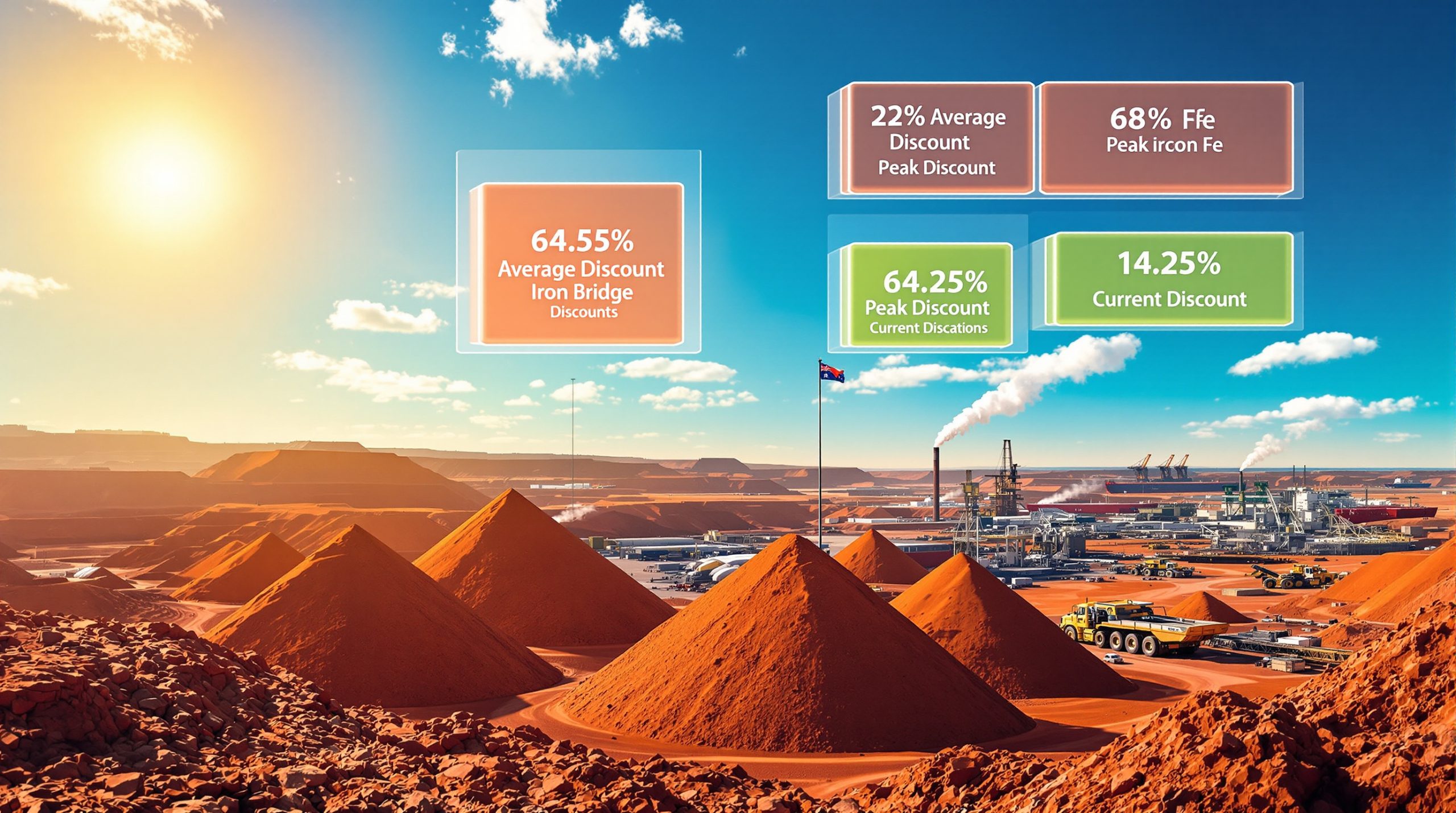The precious metals sector has experienced unprecedented volatility, with both gold and silver undergoing dramatic price swings that have reshaped investor expectations. Recent market movements, including a substantial 5-6% decline in gold prices following record highs, represent more than simple corrections. These developments signal a fundamental shift in how physical metals are valued against traditional paper-based trading mechanisms, marking what many analysts are calling a significant gold and silver market reset.
Market participants witnessed gold retreat from historic peaks, with prices moving into negative territory after achieving new records. This volatility pattern demonstrates the complex interplay between technical positioning and underlying structural changes in precious metals markets.
The Technical Foundation Behind Recent Price Movements
Market analysis reveals that both metals had reached technically overbought conditions following months of sustained upward momentum. The correction phase demonstrates classic market behavior where rapid appreciation requires consolidation periods to establish sustainable price floors.
Technical indicators suggested that gold had entered overbought territory, though this differs significantly from being overvalued from a fundamental perspective. Furthermore, our gold prices analysis reveals the distinction between these concepts proves crucial for understanding current market dynamics:
-
Overbought conditions reflect short-term technical positioning and momentum exhaustion
-
Fundamental valuation considers long-term supply-demand dynamics and monetary factors
-
Consolidation patterns typically emerge after sustained price advances to establish new support levels
The current pullback represents normal bull market behavior, where no asset moves in a straight line without periodic corrections to reset technical conditions and allow new buyers to establish positions.
Physical vs. Paper Market Divergence
A critical development has emerged in the form of backwardation across precious metals markets, where immediate delivery prices exceed future contract values. This unusual pricing structure indicates growing demand for physical possession over speculative paper positions.
The backwardation phenomenon, observable in both gold and silver markets since January, represents a significant departure from typical market structure. Under normal conditions, future delivery contracts trade at premiums to spot prices to account for storage costs and financing expenses.
However, recent analysis by Kitco suggests that whilst gold and silver experienced their worst one-day drops in years, the long-term uptrend remains intact despite short-term volatility.
Market Structure Alert: The emergence of sustained backwardation suggests physical markets are beginning to drive price discovery away from traditional paper contract mechanisms, potentially signaling a fundamental shift in precious metals pricing dynamics.
This structural change reflects several key factors:
-
Industrial demand surge creating supply constraints
-
Investment demand for physical possession over financial derivatives
-
Supply chain disruptions affecting delivery capabilities
-
Storage costs and security considerations influencing pricing
What Factors Are Driving the Precious Metals Reset?
Multiple interconnected forces have converged to create the current market environment, each contributing to increased volatility and structural changes in precious metals pricing mechanisms. In addition, these drivers represent both cyclical and secular trends that will likely influence markets for years ahead.
Central Bank Accumulation Patterns
Central banks worldwide have accelerated gold purchases, reaching levels not seen since the 1960s. This institutional buying represents a strategic shift toward reserve diversification and monetary system hedging.
Global Central Bank Gold Purchasing Analysis
| Time Period | Purchase Volume | Strategic Driver | Market Impact |
|---|---|---|---|
| 2005-2019 | Steady accumulation | Initial diversification | Foundation building |
| 2020-2022 | Accelerated buying | Pandemic response | Supply tightening |
| 2023-2024 | Record purchases | Geopolitical tensions | Price support |
| 2025 Outlook | Continued strength | De-dollarization trends | Structural demand |
Central bank purchasing patterns reveal a multi-year trend that began in 2005, with significant acceleration occurring over the past four years. This institutional demand creates a consistent bid beneath precious metals markets, providing fundamental price support even during technical corrections.
The World Gold Council reported that central bank gold purchases reached 1,037 tonnes in 2022, representing the highest annual total in over five decades. Key purchasers included emerging market central banks seeking to reduce dependence on dollar-denominated reserves.
Notable purchasing countries include:
-
Turkey – Strategic reserve diversification program
-
China – Gradual accumulation supporting yuan internationalisation
-
India – Traditional gold preference combined with modern reserve management
-
Russia – Geopolitical hedging and sanctions response
Industrial Demand Transformation
Silver's industrial applications have expanded significantly, particularly within renewable energy infrastructure and automotive electrification. This fundamental demand shift creates supply constraints that traditional mining operations struggle to address quickly.
The United States Geological Survey data indicates that industrial silver consumption accounts for approximately 50-60% of total annual demand, with photovoltaic applications representing the fastest-growing segment. Electric vehicle production requires substantially more silver content than traditional vehicles, creating additional demand pressure.
Key Industrial Applications:
-
Solar panel manufacturing – Critical component in photovoltaic cells
-
Electric vehicles – Battery technology and electrical systems
-
5G infrastructure – Communications equipment requiring high conductivity
-
Medical devices – Antimicrobial properties and electrical applications
Currency Debasement Concerns
Monetary policy decisions across major economies have created conditions that historically favour precious metals as stores of value. The Federal Reserve Economic Data (FRED) purchasing power index demonstrates systematic currency devaluation over time.
Analysis of purchasing power metrics reveals that traditional fiat currencies show systematic devaluation against hard assets. The Federal Reserve's own data indicates that the purchasing power of the consumer dollar has approached zero on their measurement scale, reflecting decades of monetary expansion.
Monetary Analysis: Current monetary systems operate on debt-based money creation, where new currency units cost virtually nothing to produce, particularly in digital form. This contrasts with precious metals, which require substantial resources to extract and refine.
Alternative valuation methodologies suggest significant precious metals undervaluation. One analytical framework involves calculating total global debt divided by total above-ground and estimated below-ground gold supplies, yielding theoretical values substantially above current market prices.
Important Disclaimer: Such alternative valuation approaches represent specific analytical frameworks and should not be considered standard Federal Reserve or mainstream economic methodologies. Investment decisions should consider multiple valuation approaches and risk factors.
How Do Interest Rate Policies Impact Precious Metals Valuations?
Federal Reserve monetary policy decisions create ripple effects throughout precious metals markets, influencing both investor behaviour and fundamental supply-demand dynamics. Current policy directions suggest continued accommodation despite recent correction activity.
The Easy Money Environment
Financial conditions remain historically accommodative according to Federal Reserve Economic Data indicators. The Financial Conditions Index shows ease levels comparable to previous periods of significant monetary stimulus, creating environments typically supportive of alternative assets including precious metals.
Market expectations for additional Federal Reserve rate cuts add further monetary accommodation to already liquid market conditions. Such policy moves historically reduce opportunity costs for holding non-yielding assets like physical precious metals.
Policy Impact Mechanisms:
-
Lower nominal rates reduce competition from yield-bearing assets
-
Real interest rates become more negative as inflation expectations rise
-
Currency debasement concerns drive alternative asset demand
-
Financial system liquidity supports risk asset positioning
Real Interest Rate Calculations
Real interest rates, calculated as nominal rates minus inflation rates, provide crucial insight into precious metals positioning dynamics. Negative real rates historically correlate with strong precious metals performance periods.
Real Rate Analysis Framework:
-
Nominal Federal Funds Rate – Current policy rate setting
-
Core CPI Inflation Rate – Underlying price pressure measure
-
Real Rate Calculation – Nominal rate minus inflation rate
-
Opportunity Cost Assessment – Comparison with alternative investments
When real rates turn negative, precious metals become more attractive relative to cash and fixed-income alternatives. Our gold price forecast suggests continued negative real rate environments, supporting fundamental precious metals demand.
What Role Does Market Structure Play in Price Discovery?
The traditional relationship between paper contracts and physical metal availability has undergone significant transformation, affecting how prices are established and maintained. This structural evolution carries important implications for investors across different precious metals exposure methods.
ETF Limitations and Investor Awareness
Exchange-traded funds tracking precious metals face structural challenges that many investors don't fully understand. These limitations become particularly relevant during periods of market stress or extended bull markets.
ETF Structure Analysis:
ETF investors own shares in trusts rather than direct metal ownership rights. This structure creates important distinctions from physical possession that investors should understand:
-
Trust ownership – Shareholders own fund shares, not underlying metals
-
Management fees – Daily expenses reduce underlying metal holdings over time
-
Liquidity constraints – Physical delivery typically unavailable to individual investors
-
Counterparty risk – Dependence on fund management and custodial arrangements
Popular precious metals ETFs like SPDR Gold Shares (GLD) and iShares Silver Trust (SLV) charge annual management fees of approximately 0.40% and 0.30% respectively. These fees require periodic selling of underlying metals to cover expenses, creating a gradual reduction in metal backing per share.
ETF Due Diligence Checklist:
-
Review current management fee structures and total expense ratios
-
Understand physical delivery policies and minimum requirements
-
Analyse tracking error versus spot metal prices over time
-
Consider tax implications relative to physical ownership
-
Evaluate custodial arrangements and storage locations
Physical Delivery Premiums
Increasing premiums for immediate physical delivery signal tightening supply conditions and growing preference for tangible asset ownership over financial derivatives. These premiums provide important market intelligence about underlying supply-demand dynamics.
Physical metal dealers report delivery premiums substantially above historical norms, particularly for smaller denomination coins and bars preferred by individual investors. Supply chain disruptions and increased demand from both institutional and retail buyers contribute to these premium structures.
Regional premium variations reflect local supply conditions, regulatory environments, and investor preferences. These differentials create arbitrage opportunities while highlighting the growing disconnect between paper and physical markets.
How Should Investors Evaluate Mining Company Fundamentals?
Mining operations face unique challenges that extend beyond simple metal price exposure, requiring comprehensive analysis of operational, political, and financial factors. Successful mining investment demands understanding of both traditional financial metrics and industry-specific risks.
Production Cost Analysis Framework
Mining cost evaluation requires examining multiple expense categories that affect profitability across different metal price environments. All-in Sustaining Costs (AISC) provide the most comprehensive measure of true production expenses.
AISC Components Analysis:
| Cost Category | Description | Impact Factor |
|---|---|---|
| Mining Costs | Extraction and processing expenses | High |
| Site Administration | Management and overhead costs | Medium |
| Sustaining Capital | Equipment replacement and maintenance | High |
| Exploration | Resource replacement activities | Medium |
| Environmental Compliance | Regulatory and remediation costs | Increasing |
Energy and labour inflation significantly impact mining economics, particularly for operations in remote locations requiring substantial power consumption. According to the World Gold Council, global AISC averages have increased substantially due to inflationary pressures across input costs.
Cost Evaluation Metrics:
-
Cash costs per ounce – Direct operational expenses
-
All-in sustaining costs – Total ongoing expenses including capital
-
Capital expenditure requirements – Future investment needs
-
Energy cost exposure – Power and fuel price sensitivity
-
Labour cost trends – Wage inflation and skill availability
Geopolitical Risk Assessment
Government intervention through taxation, royalty adjustments, or operational restrictions can significantly impact mining profitability. Political stability and regulatory environments require careful evaluation, particularly for operations in emerging markets.
Mining companies operating in certain African jurisdictions face currency-related challenges where local regulations require selling portions of production in rapidly devaluing local currencies. These forced sales can substantially impact realised prices even when global metal prices remain strong.
Key Risk Factors:
-
Royalty rate changes – Government revenue adjustments
-
Currency controls – Local sales requirements and exchange restrictions
-
Environmental regulations – Changing compliance requirements
-
Political stability – Regime change and policy continuity risks
-
Infrastructure quality – Transportation and utilities reliability
Specific examples include regulatory requirements in some African mining jurisdictions mandating that miners sell approximately 20% of production in local currency during periods of hyperinflation, effectively creating significant realised price reductions despite strong global metal prices.
Risk Mitigation Strategies:
-
Geographic diversification – Multiple jurisdiction exposure
-
Currency hedging – Financial instruments to manage exchange risk
-
Government relations – Proactive stakeholder engagement
-
Insurance coverage – Political risk and operational protection
What Are the Long-Term Implications of This Market Reset?
The current precious metals correction may represent the beginning of a broader monetary system transition, with significant implications for investors and global financial stability. Understanding these potential changes helps inform long-term positioning strategies.
Fundamental Value Calculations
Alternative analytical frameworks suggest significant precious metals undervaluation relative to monetary base expansion and debt creation. These methodologies, whilst not representing mainstream economic consensus, provide interesting perspective on potential future pricing scenarios.
One alternative calculation approach involves analysing total global debt relative to total gold supplies (both above-ground and estimated reserves). This methodology yields theoretical gold values substantially above current market prices, though such calculations require careful interpretation and should not be considered standard valuation approaches.
Alternative Valuation Components:
-
Total global debt – Sovereign, corporate, and personal obligations
-
Above-ground gold supply – Estimated at approximately 200,000 tonnes
-
Below-ground reserves – Proven and probable mining reserves
-
Calculation methodology – Debt divided by total gold supply
Important Disclaimer: Alternative valuation methodologies represent specific analytical frameworks and should be considered alongside traditional economic analysis. These approaches do not represent Federal Reserve or mainstream economic consensus. Investment decisions should incorporate multiple analytical approaches and comprehensive risk assessment.
Portfolio Positioning Strategies
Strategic precious metals allocation requires balancing multiple objectives including wealth preservation, growth potential, and risk management. Different exposure methods offer varying risk-return profiles suitable for different investor circumstances.
Allocation Framework Options:
| Strategy Type | Allocation | Risk Level | Objective |
|---|---|---|---|
| Core Holdings | 5-15% physical metals | Low-Medium | Wealth preservation |
| Tactical Positions | 3-8% mining equities | Medium-High | Leverage to metal prices |
| Income Generation | 2-5% royalty companies | Low-Medium | Steady cash flow |
| Speculative Component | 1-3% junior miners | High | Growth potential |
Physical metals provide direct exposure without counterparty risk but offer no yield generation. Mining equities provide leveraged exposure to metal price movements but carry operational and political risks. Consequently, our gold-stock market guide shows that royalty companies offer income potential with lower operational risk than traditional miners.
Portfolio Construction Considerations:
-
Risk tolerance – Personal comfort with volatility levels
-
Investment horizon – Time frame for holding positions
-
Liquidity needs – Access requirements for invested capital
-
Tax implications – Treatment differences across exposure methods
-
Storage requirements – Physical metal custody arrangements
Frequently Asked Questions About Precious Metals Market Reset
Is This Correction Normal for Bull Markets?
Historical analysis shows that corrections of 10-15% in gold and 15-20% in silver are typical during sustained uptrends. These consolidation phases often create stronger foundations for subsequent price advances by resetting technical conditions and allowing new participants to establish positions.
According to World Gold Council historical data, gold bull markets typically experience multiple correction phases lasting several months each. These pullbacks serve important market functions by:
-
Reducing technical overbought conditions that limit further advances
-
Allowing fundamental demand to catch up with price appreciation
-
Creating entry opportunities for new investors
-
Testing support levels to establish sustainable price floors
The current correction magnitude falls within normal parameters for precious metals bull market behaviour, suggesting healthy market dynamics rather than fundamental trend changes. Moreover, the gold market surge continues to show underlying strength despite temporary volatility.
How Long Do Precious Metals Corrections Typically Last?
Market cycle analysis suggests correction phases generally persist for 2-6 months, depending on underlying fundamental drivers and broader economic conditions. Technical support levels provide guidance for potential reversal points and correction duration estimates.
Historical correction analysis reveals several common patterns:
-
Brief corrections (1-2 months) – Technical adjustments during strong trends
-
Standard corrections (3-4 months) – Normal consolidation periods
-
Extended corrections (5-6+ months) – Fundamental reassessment phases
Current fundamental drivers including central bank accumulation, industrial demand growth, and monetary policy accommodation suggest the underlying bull market structure remains intact despite short-term price volatility.
Should Investors Buy During Market Weakness?
Dollar-cost averaging during volatile periods can reduce timing risk whilst building positions at more attractive price levels. Quality mining operations and physical metals often present compelling value during sector-wide corrections.
Accumulation Strategy Guidelines:
-
Gradual position building rather than lump-sum investment
-
Quality focus on established operations and reputable dealers
-
Risk management through position sizing and diversification
-
Fundamental analysis to distinguish temporary corrections from trend changes
Market weakness provides opportunities for long-term investors to establish or add to precious metals positions at more favourable pricing levels, particularly when fundamental drivers remain supportive. For instance, Bloomberg's analysis indicates that whilst gold and silver posted their steepest drops in years amid broader market selloffs, the gold and silver market reset may create strategic entry points.
Preparing for the Next Phase of Precious Metals Markets
Understanding current market dynamics positions investors to navigate future volatility whilst capitalising on structural changes in precious metals valuation mechanisms. Preparation involves both technical analysis and fundamental research to identify emerging opportunities.
Technical Indicators to Monitor
Key support and resistance levels provide guidance for entry and exit decisions, whilst momentum indicators help identify trend reversals and continuation patterns. Technical analysis tools offer valuable insights when combined with fundamental analysis.
Essential Technical Indicators:
-
Moving averages – Trend direction and support/resistance levels
-
Relative Strength Index (RSI) – Overbought and oversold conditions
-
MACD indicators – Momentum changes and trend confirmation
-
Volume analysis – Confirmation of price movements
-
Support/resistance levels – Key price zones for decision-making
Current technical analysis suggests gold and silver are working through normal correction phases whilst maintaining longer-term uptrend structures. Key support levels provide guidance for potential accumulation zones.
Fundamental Catalysts Ahead
Supply constraints, monetary policy developments, and geopolitical factors will likely drive the next phase of precious metals price action, creating opportunities for prepared investors who understand these dynamics.
Upcoming Catalyst Categories:
-
Central bank policy decisions – Interest rate and money supply changes
-
Geopolitical developments – International tensions and trade relationships
-
Supply disruptions – Mining challenges and transportation issues
-
Industrial demand shifts – Technology adoption and infrastructure investment
-
Currency instability – Emerging market financial stress
Furthermore, our gold-silver ratio insights provide valuable perspective on relative metal valuations during this transition period.
Strategic Outlook: The convergence of technical corrections with fundamental supply-demand imbalances suggests the current gold and silver market reset may establish launching points for the next significant price advance in precious metals markets.
Investors who understand these dynamics and maintain disciplined approaches to precious metals allocation may benefit from the current market reset phase whilst positioning for potential future opportunities.
Investment Preparation Checklist:
-
Education – Understanding market structure and dynamics
-
Strategy development – Clear allocation and risk management plans
-
Due diligence – Research on specific investment options
-
Timing flexibility – Patience for optimal entry opportunities
-
Professional guidance – Consultation with qualified investment professionals
This analysis is provided for educational purposes and should not be considered personalised investment advice. Precious metals investing involves risks including price volatility, storage costs, and liquidity considerations. Investors should conduct thorough research and consider consulting with qualified financial professionals before making investment decisions.
Ready to Capitalise on the Next Major Precious Metals Discovery?
Discovery Alert provides instant notifications on significant ASX mineral discoveries using its proprietary Discovery IQ model, delivering actionable insights that can help investors identify opportunities ahead of the broader market during this precious metals reset. Visit Discovery Alert's dedicated discoveries page to understand how historic discoveries have generated substantial returns, and begin your 30-day free trial today to position yourself strategically for the next phase of precious metals markets.




